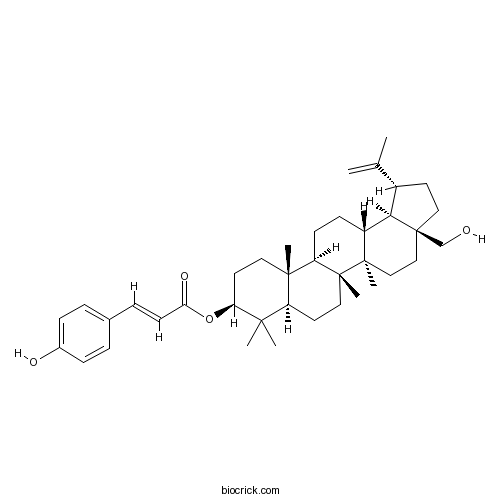3-O-(E)-p-CoumaroylbetulinCAS# 144424-80-6 |

Quality Control & MSDS
3D structure
Package In Stock
Number of papers citing our products

| Cas No. | 144424-80-6 | SDF | Download SDF |
| PubChem ID | 12086730 | Appearance | Powder |
| Formula | C39H56O4 | M.Wt | 588.9 |
| Type of Compound | Triterpenoids | Storage | Desiccate at -20°C |
| Solubility | Soluble in Chloroform,Dichloromethane,Ethyl Acetate,DMSO,Acetone,etc. | ||
| Chemical Name | [(1R,3aS,5aR,5bR,7aR,9S,11aR,11bR,13aR,13bR)-3a-(hydroxymethyl)-5a,5b,8,8,11a-pentamethyl-1-prop-1-en-2-yl-1,2,3,4,5,6,7,7a,9,10,11,11b,12,13,13a,13b-hexadecahydrocyclopenta[a]chrysen-9-yl] (E)-3-(4-hydroxyphenyl)prop-2-enoate | ||
| SMILES | CC(=C)C1CCC2(C1C3CCC4C5(CCC(C(C5CCC4(C3(CC2)C)C)(C)C)OC(=O)C=CC6=CC=C(C=C6)O)C)CO | ||
| Standard InChIKey | FKTQBZHKUPHHSC-LNVBJZNQSA-N | ||
| General tips | For obtaining a higher solubility , please warm the tube at 37 ℃ and shake it in the ultrasonic bath for a while.Stock solution can be stored below -20℃ for several months. We recommend that you prepare and use the solution on the same day. However, if the test schedule requires, the stock solutions can be prepared in advance, and the stock solution must be sealed and stored below -20℃. In general, the stock solution can be kept for several months. Before use, we recommend that you leave the vial at room temperature for at least an hour before opening it. |
||
| About Packaging | 1. The packaging of the product may be reversed during transportation, cause the high purity compounds to adhere to the neck or cap of the vial.Take the vail out of its packaging and shake gently until the compounds fall to the bottom of the vial. 2. For liquid products, please centrifuge at 500xg to gather the liquid to the bottom of the vial. 3. Try to avoid loss or contamination during the experiment. |
||
| Shipping Condition | Packaging according to customer requirements(5mg, 10mg, 20mg and more). Ship via FedEx, DHL, UPS, EMS or other couriers with RT, or blue ice upon request. | ||
| Description | 1. 3-β-O-trans-p-coumaroylbetulinol has anti-angiogenic effect, it possesses significant anti-proliferative activity with 66.7% inhibition at 100uM. |

3-O-(E)-p-Coumaroylbetulin Dilution Calculator

3-O-(E)-p-Coumaroylbetulin Molarity Calculator
| 1 mg | 5 mg | 10 mg | 20 mg | 25 mg | |
| 1 mM | 1.6981 mL | 8.4904 mL | 16.9808 mL | 33.9616 mL | 42.452 mL |
| 5 mM | 0.3396 mL | 1.6981 mL | 3.3962 mL | 6.7923 mL | 8.4904 mL |
| 10 mM | 0.1698 mL | 0.849 mL | 1.6981 mL | 3.3962 mL | 4.2452 mL |
| 50 mM | 0.034 mL | 0.1698 mL | 0.3396 mL | 0.6792 mL | 0.849 mL |
| 100 mM | 0.017 mL | 0.0849 mL | 0.1698 mL | 0.3396 mL | 0.4245 mL |
| * Note: If you are in the process of experiment, it's necessary to make the dilution ratios of the samples. The dilution data above is only for reference. Normally, it's can get a better solubility within lower of Concentrations. | |||||

Calcutta University

University of Minnesota

University of Maryland School of Medicine

University of Illinois at Chicago

The Ohio State University

University of Zurich

Harvard University

Colorado State University

Auburn University

Yale University

Worcester Polytechnic Institute

Washington State University

Stanford University

University of Leipzig

Universidade da Beira Interior

The Institute of Cancer Research

Heidelberg University

University of Amsterdam

University of Auckland

TsingHua University

The University of Michigan

Miami University

DRURY University

Jilin University

Fudan University

Wuhan University

Sun Yat-sen University

Universite de Paris

Deemed University

Auckland University

The University of Tokyo

Korea University
- Canophyllal
Catalog No.:BCN7441
CAS No.:14440-40-5
- 3-Oxopomolic acid methyl ester
Catalog No.:BCN3723
CAS No.:14440-23-4
- 8-(7-Hydroxy-3,7-dimethyl-2,5-octadienyloxy)psoralen
Catalog No.:BCN1567
CAS No.:144398-34-5
- GSK2838232
Catalog No.:BCC6372
CAS No.:1443461-21-9
- CCG 203971
Catalog No.:BCC5601
CAS No.:1443437-74-8
- Nemoralisin C
Catalog No.:BCN7680
CAS No.:1443421-84-8
- YM 26734
Catalog No.:BCC7396
CAS No.:144337-18-8
- Trilepisflavan
Catalog No.:BCN6786
CAS No.:1443218-16-3
- 1-Deazaadenosine
Catalog No.:BCC6204
CAS No.:14432-09-8
- ML 337
Catalog No.:BCC6345
CAS No.:1443118-44-2
- Dehydroadynerigenin glucosyldigitaloside
Catalog No.:BCN1568
CAS No.:144223-70-1
- YYA-021
Catalog No.:BCC5346
CAS No.:144217-65-2
- Aflavarin
Catalog No.:BCN7410
CAS No.:144429-67-4
- Goniodiol 8-acetate
Catalog No.:BCN4787
CAS No.:144429-71-0
- Beta-Aflatrem
Catalog No.:BCN6699
CAS No.:144446-23-1
- Clopidogrel Related Compound A
Catalog No.:BCN2687
CAS No.:144457-28-3
- Tirofiban
Catalog No.:BCC4868
CAS No.:144494-65-5
- Licochalcone C
Catalog No.:BCN6334
CAS No.:144506-14-9
- Rotundatin
Catalog No.:BCN7856
CAS No.:144506-16-1
- Cannabisin D
Catalog No.:BCN2547
CAS No.:144506-19-4
- Pixantrone
Catalog No.:BCC5222
CAS No.:144510-96-3
- Isorhynchophyllic acid
Catalog No.:BCN4980
CAS No.:144525-05-3
- Oxyresveratrol 3'-O-beta-D-glucopyranoside
Catalog No.:BCN1566
CAS No.:144525-40-6
- Murrayanol
Catalog No.:BCN3178
CAS No.:144525-81-5
Antitumor-promoting constituents from Chaenomeles sinensis KOEHNE and their activities in JB6 mouse epidermal cells.[Pubmed:14600382]
Chem Pharm Bull (Tokyo). 2003 Nov;51(11):1318-21.
Primary screening of antitumor-promoting activity using soft agar colony assays with JB6 cells was employed to isolate 22 compounds from Chaenomeles sinensis KOEHNE. These compounds were lyoniresinol-2a-O-alpha-L-rhamnopyranoside (1), lyoniresinol-2a-O-beta-D-glucopyranoside (2), aviculin (3), betulinic acid (4), betulin (5), 3-O-(E)-p-Coumaroylbetulin (6), 3-O-(E)-caffeoylbetulin (7), 3-O-(Z)-p-coumaroylbetulin (8), 3-O-(E)-caffeoyllupeol (9), alphitolic acid (10), sorbikortal II (11), tormentic acid (12), euscaphic acid (13), corosolic acid (14), maslinic acid (15), erythrodiol (16), 1-beta-D-glucopyranosyloxy-3,4,5-trimethoxybenzene (17), avicularin (18), 7-O-beta-D-glucopyranosylkaempferol (19), 5-O-beta-D-glucopyranosylgenistein (20), 7-O-beta-D-glucopyranosylgenistein (21), epicatechin (22), and beta-sitosterol (23) and were identified using spectral data such as MS, (1)H- and (13)C-NMR. Compound 1, having a rhamnosyl group, showed greater activity than 2, having a glucosyl group, and 3, which was a bis-demethoxy derivative of 1. Betulinic acid (4), having a C-28 carboxyl group, 3-O-(E)-caffeoylbetulin (7), and tormentic acid (12) showed more potent activity than betulin (5), which has a C-28 hydroxymethyl group.


